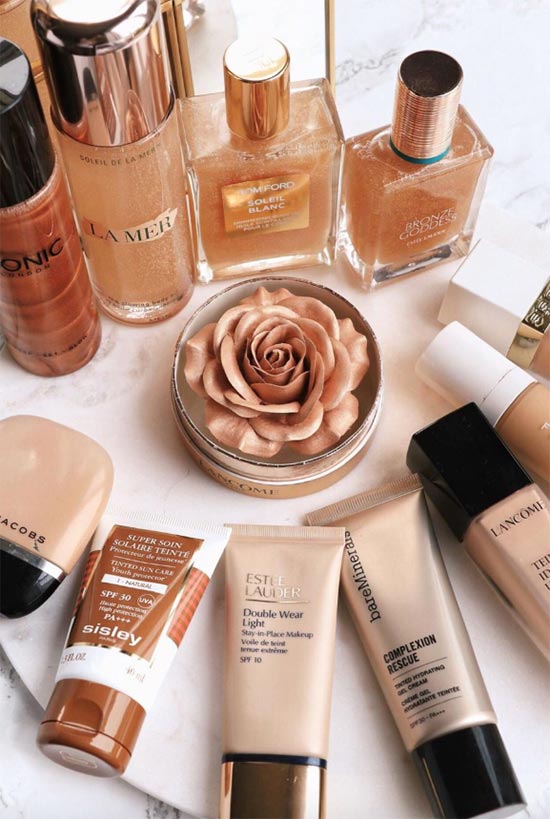Tinted sunscreens somehow manage to avoid the typical pitfalls of SPF products to offer comfortable sun protection. In this article, we explain what tinted sunscreen is and outline all of its benefits. We also explain what the difference is between tinted sunscreen and other similar products like tinted moisturizers and foundations. Last but not least, we finish with a thorough explanation on the best way to apply a tinted sunscreen.
In this article:
- What Is Tinted Sunscreen?
- Tinted Sunscreen Benefits
- Tinted Sunscreen vs. Tinted Moisturizer vs. Foundation
- How to Apply Tinted Sunscreen
What Is Tinted Sunscreen?
Tinted sunscreen is sunscreen with a bit of pigment in it. They are almost always mineral sunscreens, which contain zinc oxide or titanium dioxide as their active ingredients, which ensure that the formula will offer sun protection.
Both zinc oxide and titanium dioxide are white in color, so a lot of regular mineral sunscreens will leave a “white cast,” which will tint the skin slightly white. This can make a person look like they’re wearing overly light makeup or it might turn their skin purple, gray or ashy.
In order to cancel out the white cast, brands started adding mineral pigments (usually iron oxides) to their sunscreens. These mineral pigments are the same ones used to color makeup products, so in doing so, brands effectively blur the line between face sunscreen and makeup. However, usually, the amount of pigment in a tinted sunscreen is just high enough to cancel the whiteness without covering the skin too much.
This is why most brands release just one universal shade of tinted sunscreen that is meant to work for a wide range of skin tones. In some instances, they succeed, while in other instances they end up releasing a sunscreen that will only work for light to medium skin tones, thereby discriminating against people of color.
We’ve focused our list of the best tinted sunscreens on either truly universal options or brands that offer multiple colors, but there are still a few brands in there that are not totally universal, which I made sure to point out.

Tinted Sunscreen Benefits
Tinted sunscreens are great for everyone, but especially for folks with sensitive skin! These are the main benefits of tinted sunscreen:
- Tinted sunscreens protect the skin from the sun, thereby preventing sunburn, skin cancer, and premature aging.
- They are usually made with mineral sunscreen ingredients like titanium dioxide or zinc oxide, which makes them better for those who have sensitive skin.
- Unlike untinted mineral sunscreens, they don’t leave a white cast over the skin, but instead, they blend in seamlessly.
- Despite the tint, tinted sunscreens do not look like makeup. They may even out the skin tone slightly but they look completely natural.
- Tinted sunscreens tend to layer very nicely under makeup, so they can double as makeup primers, especially if they contain silicone or coconut alkanes.
Tinted Sunscreen vs. Tinted Moisturizer vs. Foundation
While some tinted moisturizers and foundations might offer sun protection that is just as high as a tinted moisturizer, there are actually fairly distinct differences across the three categories. All three products can be sunscreens, in the sense that all three products can have adequate SPF protection. However, when we look at the details we can see that the term ‘tinted sunscreen’ refers to a very specific kind of product.
Tinted sunscreens almost always provide less coverage than a tinted moisturizer. This is because tinted sunscreens are meant to be skincare first and foremost, with the tint in place only to avoid a white cast.
With a tinted moisturizer, the line between skincare products and makeup becomes blurrier. While the coverage of a tinted moisturizer is almost always light, it will still help cover some discoloration. It’s very rare that this is the case with a tinted sunscreen.
The second difference between tinted moisturizers and tinted sunscreens is a less rigid one. Generally, a tinted sunscreen is not going to provide enough hydration to the skin on its own, even if the wearer has oily skin.

Some tinted sunscreen formulas can be moisturizing, but most aren’t so you will need to apply a hydrating essence or moisturizer first. With tinted moisturizers, those with oily skin usually don’t have to apply any moisturizer beforehand.
The final difference is when it comes to sun protection. Tinted sunscreens almost always offer at least 30 SPF, whereas tinted moisturizers don’t have to offer any protection at all. Many of them do, and often it is very high. The complication is that tinted moisturizers are often too pigmented to look good at the right quantity.
We have to apply around a ¼ teaspoon of sunscreen in order to get enough coverage, and when it comes to tinted moisturizer that’s just too much product for most of us. It is much easier to apply the correct amount when using the less pigmented tinted sunscreen.
Now let’s talk really quickly about foundations. Tinted moisturizer could be considered a sub-category of foundation since the term can apply to any makeup product that is meant to match the skin tone and be applied all over the face. Since the primary purpose of a tinted sunscreen is to offer sun protection, it wouldn’t fall under the foundation category except perhaps in the very rare cases when a formula happens to be more pigmented than normal.

How to Apply Tinted Sunscreen
This is the correct order of tinted sunscreen application to follow:
- Cleanse and Moisturize
Depending on your tinted sunscreen and skin type, start with either clean or moisturized skin. You can smooth on a light, hydrating essence if you want a moisture boost that’ll sink in quickly.
- Measure It out
Dispense a ¼ teaspoon of tinted sunscreen in the palm of your hand. This is the amount normally recommended to make sure that you will get the full SPF of the product. Using too little reduces the SPF exponentially, meaning that you can seriously underestimate how much protection you get from your sunscreen.
I really recommend measuring it out the first time, and then learning what it looks like in your palm. If you have a smaller face and a ¼ teaspoon seems like too much, you can try and estimate what 2 milligrams per square centimeter would be on your face using a tape measuring technique. - Dot It over Your Face
To apply the tinted sunscreen, dot it over your face focusing on the high points like the forehead, nose, chin, and cheeks.
- Smooth It out
Then smooth it into your skin in gentle, outward motions, making sure the entirety of your face is covered. Be careful not to over-blend or you’ll remove some of the sunscreen and reduce the protection.
If you find that it’s too difficult to get the sunscreen to blend into your skin in one go, you can split the amount of sunscreen and put it on in two applications, waiting 5-10 minutes in between each application. - Add a Second Layer
If your tinted sunscreen is looking a little streaky you can give it a few moments to sink in better, and then go in with a bit more product on your fingers, brush, or makeup sponge to blend things out. By doing this with a touch more product you can ensure a seamless finish but with total sun protection.
- Apply on Your Neck and Chest Too!
Don’t forget your neck and chest! Dispense more product and apply it to your neck and chest if you are going to be showing a bit more skin.
- Let It Dry
Give your tinted sunscreen enough time to dry down (at least a few minutes, but the longer you wait, the better) before applying a primer or makeup.
Photos via @raffaellaferrigno, Instagram





